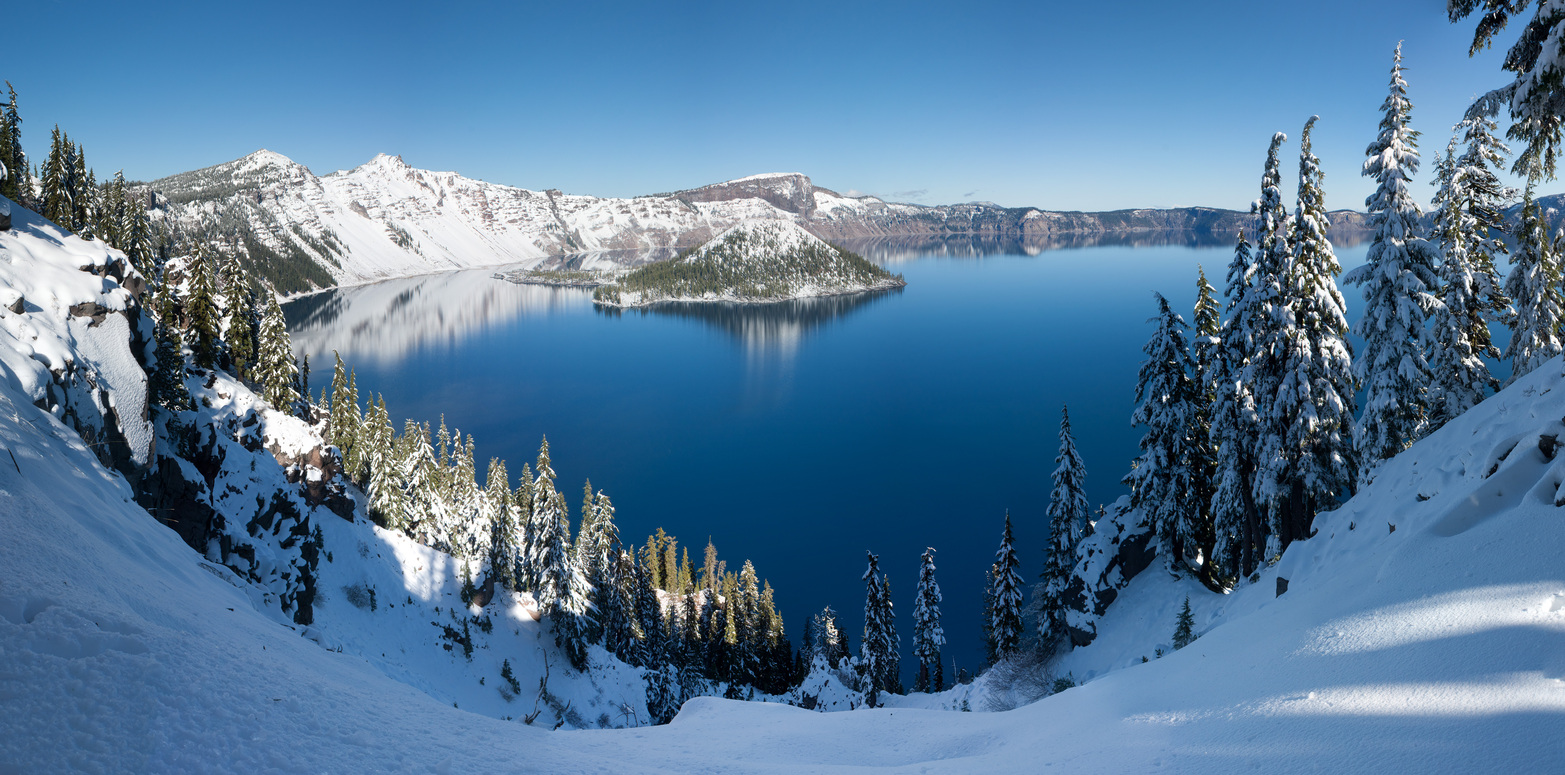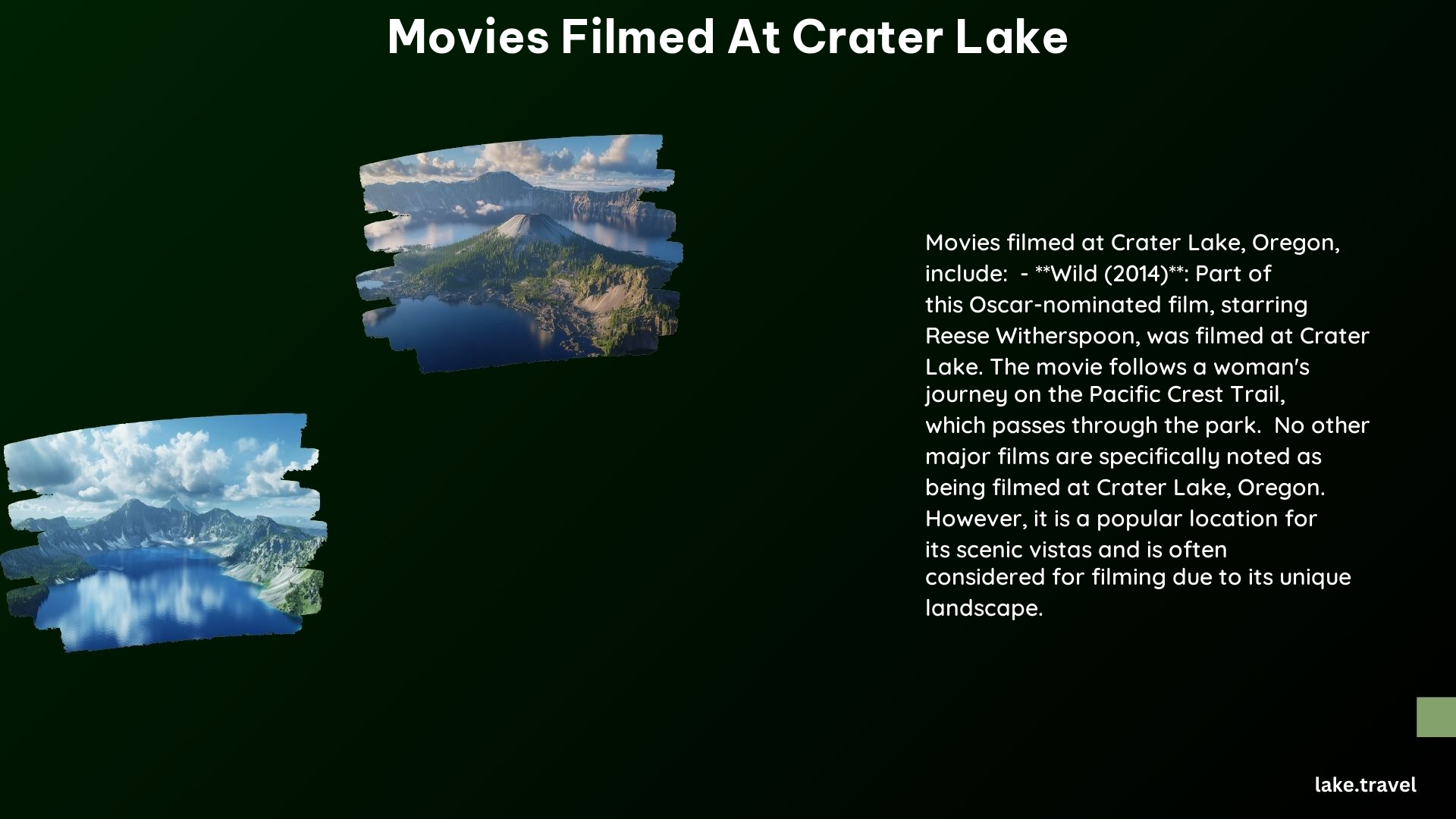Crater Lake, with its pristine blue waters and stunning volcanic landscape, has captivated filmmakers and audiences alike. Despite its breathtaking beauty, only one major film has been shot at this iconic Oregon location. “Wild” (2014), starring Reese Witherspoon, showcases Crater Lake’s majestic scenery as part of the Pacific Crest Trail. This article explores the cinematic history of Crater Lake, delving into the challenges and rewards of filming in this unique national park.
What Makes Crater Lake a Unique Filming Location?

Crater Lake’s unparalleled beauty and geological significance make it a compelling backdrop for filmmakers. Here’s why this location stands out:
- Deepest lake in the United States
- Intense blue water color due to its depth and purity
- Surrounded by steep cliffs rising up to 2,000 feet
- Volcanic history and unique formation
- Diverse ecosystem and wildlife
These features create a visually stunning and dramatic setting for any film production. However, the park’s remote location and strict preservation rules present unique challenges for filmmakers.
Which Major Film Was Shot at Crater Lake?

The most notable film shot at Crater Lake is “Wild” (2014), directed by Jean-Marc Vallée and starring Reese Witherspoon. This biographical drama tells the story of Cheryl Strayed’s 1,100-mile solo hike along the Pacific Crest Trail.
Key Details about “Wild”:
- Release Year: 2014
- Director: Jean-Marc Vallée
- Lead Actress: Reese Witherspoon
- Based on: Cheryl Strayed’s memoir “Wild: From Lost to Found on the Pacific Crest Trail”
- Plot: A woman’s journey of self-discovery as she hikes the Pacific Crest Trail
How Does Crater Lake Feature in “Wild”?
Crater Lake plays a significant role in “Wild” as part of Cheryl Strayed’s journey along the Pacific Crest Trail. The film captures the lake’s stunning beauty and the surrounding landscape, showcasing:
- Panoramic views of the deep blue waters
- The rugged terrain of the Pacific Crest Trail
- The stark contrast between the lake and the surrounding forest
These scenes not only add visual splendor to the film but also symbolize the protagonist’s internal journey and the transformative power of nature.
What Challenges Do Filmmakers Face When Shooting at Crater Lake?
Filming at Crater Lake presents several unique challenges:
- Permit Requirements: All commercial filming requires permits from the National Park Service.
- Environmental Concerns: Strict regulations to protect the park’s ecosystem.
- Weather Conditions: Unpredictable weather, especially during winter months.
- Limited Access: Some areas of the park are closed to protect wildlife and vegetation.
- Logistical Issues: Remote location can make equipment transport difficult.
Table: Permit Requirements for Filming at Crater Lake
| Requirement | Details |
|---|---|
| Application Timeline | 4 weeks for simple shoots, 10 weeks for complex ones |
| Insurance | Proof of insurance mandatory |
| Fees | Based on crew size and project scope |
| Environmental Impact | Must demonstrate minimal impact on park resources |
| Seasonal Restrictions | Filming may be limited during peak tourist seasons |
How Has Crater Lake Influenced Other Forms of Media?
While “Wild” is the only major film shot at Crater Lake, the park’s beauty has inspired various other media forms:
- Documentaries: Nature and geological documentaries often feature Crater Lake.
- Photography: Countless professional and amateur photographers capture the lake’s beauty.
- Literature: The lake has been the subject of numerous books and articles.
- Art: Painters and digital artists frequently depict Crater Lake in their work.
What Are Some Misconceptions About Films at Crater Lake?
One common misconception involves the 1977 film “The Crater Lake Monster.” Despite its title, this B-movie was not actually filmed at Crater Lake. Instead, it was shot at Huntington Lake in California. This misunderstanding highlights the importance of verifying filming locations and not relying solely on movie titles.
How Can Visitors Experience the Cinematic Side of Crater Lake?
For film enthusiasts and nature lovers alike, visiting Crater Lake can offer a unique experience:
- Hike the Pacific Crest Trail: Follow in Cheryl Strayed’s footsteps from “Wild.”
- Scenic Drives: Take the 33-mile Rim Drive for panoramic views featured in documentaries.
- Boat Tours: Experience the lake from water level, offering a different perspective from what’s seen in films.
- Ranger-Led Programs: Learn about the park’s geology and ecology, often featured in educational films.
- Photography Workshops: Capture your own cinematic views of the lake.
What Future Potential Does Crater Lake Hold for Filmmakers?
While only one major film has been shot at Crater Lake so far, the location holds immense potential for future productions:
- Science Fiction: The otherworldly landscape could serve as an alien planet.
- Environmental Documentaries: Showcasing the impact of climate change on pristine environments.
- Adventure Films: The challenging terrain provides a perfect backdrop for survival stories.
- Romantic Dramas: The stunning scenery offers a romantic setting for love stories.
- Historical Epics: Depicting Native American history or early exploration of the area.
How Does Filming at Crater Lake Compare to Other National Parks?
While Crater Lake has seen limited film production, other national parks have been more frequently featured in movies:
- Yosemite: Featured in “The Last of the Mohicans” and “Star Trek V: The Final Frontier”
- Grand Canyon: Backdrop for “Thelma & Louise” and “Into the Wild”
- Yellowstone: Seen in “Forrest Gump” and “A River Runs Through It”
Crater Lake’s unique challenges, including its remote location and strict preservation rules, may contribute to its limited use in major film productions compared to these other parks.
What Impact Does Filming Have on Crater Lake’s Ecosystem?
The National Park Service carefully balances the desire for media exposure with the need to protect Crater Lake’s delicate ecosystem:
- Restricted Areas: Certain sensitive areas are off-limits to filming.
- Wildlife Protection: Strict rules about approaching or disturbing wildlife.
- Waste Management: Film crews must adhere to “Leave No Trace” principles.
- Vegetation Preservation: No alteration of the natural landscape is allowed.
- Noise Pollution: Limits on equipment and crew size to minimize disturbance.
By enforcing these regulations, the park ensures that filming activities do not negatively impact the natural environment that makes Crater Lake so special.
In conclusion, while Crater Lake’s cinematic history may be limited to one major film, its potential as a filming location remains vast. The challenges of shooting in this pristine environment are balanced by the unparalleled beauty it offers. As filmmakers continue to seek unique and awe-inspiring locations, Crater Lake stands ready to provide a backdrop of unmatched natural splendor, ensuring its place in the annals of cinematic geography.
References:
1. The Crater Lake Monster – Wikipedia
2. Film Location: Crater Lake, Oregon – Emerge Film Solutions
3. Filmed in Oregon – Travel Oregon
